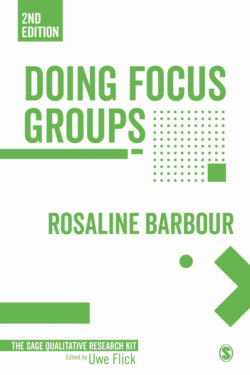Читать книгу Doing Focus Groups - Rosaline Barbour - Страница 22
На сайте Литреса книга снята с продажи.
Researchers’ or participants’ concerns?
ОглавлениеWhile the appearance of terms such as ‘non-adherence’ or ‘non-compliance’ can signal research carried out with this partial or partisan professional view, focus group research, again, spans a continuum. Even where the original concern is that of ‘non-adherence’, focus groups can provide valuable explanations, in terms, for example, of identifying competing priorities for patients. Bloor et al. (2001) argue that focus groups are particularly well suited to studying decision-making processes, for example, and the ways in which people weigh up competing priorities or the ways in which they qualify their views to take situational and circumstantial factors into account. Some research uses focus groups in this way in order to elucidate the decision-making processes involved – e.g. non-adherence to osteoporosis medications (Iversen et al., 2011); or adolescents’ use of inhaled asthma controller medication (Wamboldt et al., 2011).
Focus groups have also been used to provide a greater understanding of apparently illogical health-related behaviours, such as neglecting to take folic acid (Barbour et al., 2012) while pregnant. Such studies are characterized by a focus on the importance of lay understandings and take, as their starting point, the notion that apparently illogical beliefs and practices, once viewed from the perspectives of the people involved, are likely to display a coherent and possibly highly sophisticated logic. This, however, only becomes apparent when focus group participants are given scope to justify and expand on their views in a non-judgemental environment.
Some clinician-researchers have built on the findings from focus group studies in order to develop enhanced or more appropriate messages or treatment packages for specific groups of patients. Bryan et al. (2008) used focus groups to adapt ethnically appropriate, information-seeking and recruitment messages for a prostate cancer screening programme for men at high risk. A further example is provided by Bottorff et al. (2014) who designed tailored messages about the link between tobacco exposure and breast cancer for First Nations people and Métis in Canada. Such usages bring to mind the approaches used in marketing research with the aim of producing messages designed for particular target audiences and fall into the orbit of ‘social marketing’. A recent critique of social marketing (Crawshaw, 2012) points out that it consistently fails to take adequate account of the day-to-day lives, priorities and constraints of the individuals and groups being addressed.
The researcher working in this area treads a narrow line between encouragement, persuasion and empowerment, and much depends on the way in which focus groups are carried out, how they are embedded in studies and, importantly, who has commissioned the research and what is done with the findings. Certainly, much of the knowledge underpinning health promotion advice is essentially provisional in nature (with recommendations frequently being withdrawn or even reversed), and health professionals’ firmly held convictions should, perhaps, be subjected to a degree of scrutiny similar to that reserved for exploring the lack of conviction of their patients or clients. (This raises particularly difficult questions for social scientists engaged in health services research with practitioners/clinical colleagues.) Ultimately, it is possibly the extent and nature of consultation with patients in the course of a project that separates the potentially coercive from the potentially empowering in this field of research. Drawing on a model more akin to that espoused by design researchers, Stellefson et al. (2010) produced and proceeded to test and refine prototype materials for chronic obstructive pulmonary disease (COPD) self-management education DVDs for a rural population. While this approach admittedly accepts without question the value of self-management, there is evidence of a genuine attempt to engage with users and to seek to reflect their concerns.
The knowledge of clinicians and other professionals can undoubtedly be enhanced through focus group findings which provide an understanding of the processes involved and which can offer the potential to take account of the findings in future practice. A focus group study of the needs of released prisoners (Luther et al., 2011), for example, focused on identifying the implications for practice in order to limit return to high-risk behaviour in relation to HIV/AIDS.
Moran et al. (2012) provide an interesting example of an approach which successfully combined two orientations – that of focusing on specific practice issues and providing unanticipated insights. They were concerned to establish what patients (with ADHD and autistic spectrum disorders) and carers thought of routine outcome measures used in a Child and Adolescent Mental Health service. Although the emphasis was predominantly on the outcome measures and researchers sought to determine levels of agreement (using kappa coefficients), nevertheless, the discussion identified some broader and potentially useful concerns – interestingly, described as ‘irrelevant’ in terms of the original aims of the research:
One predominant fear was a fear of discharge and subsequent lack of access to support should problems recur in the future. Carers wanted rapid access to advice that they could dip in and out of, and were worried that outcome monitoring would be used to limit access to services. (2012, p. 74)
Similarly, den Oudsten et al. (2011) – in this case, alongside a large quantitative international collaboration – carried out focus groups with people with Parkinson’s disease, their family carers and professionals in order to establish their views on quality of life measures. The researchers reported that this exercise identified important new themes.
However, focus groups have added potential – particularly for the practitioner– researcher – for use in overtly action-research-oriented projects. Crabtree et al. argue that ‘it is possible to use focus groups as a data collection tool and an intervention simultaneously’ (Crabtree et al., 1993, p. 146).
